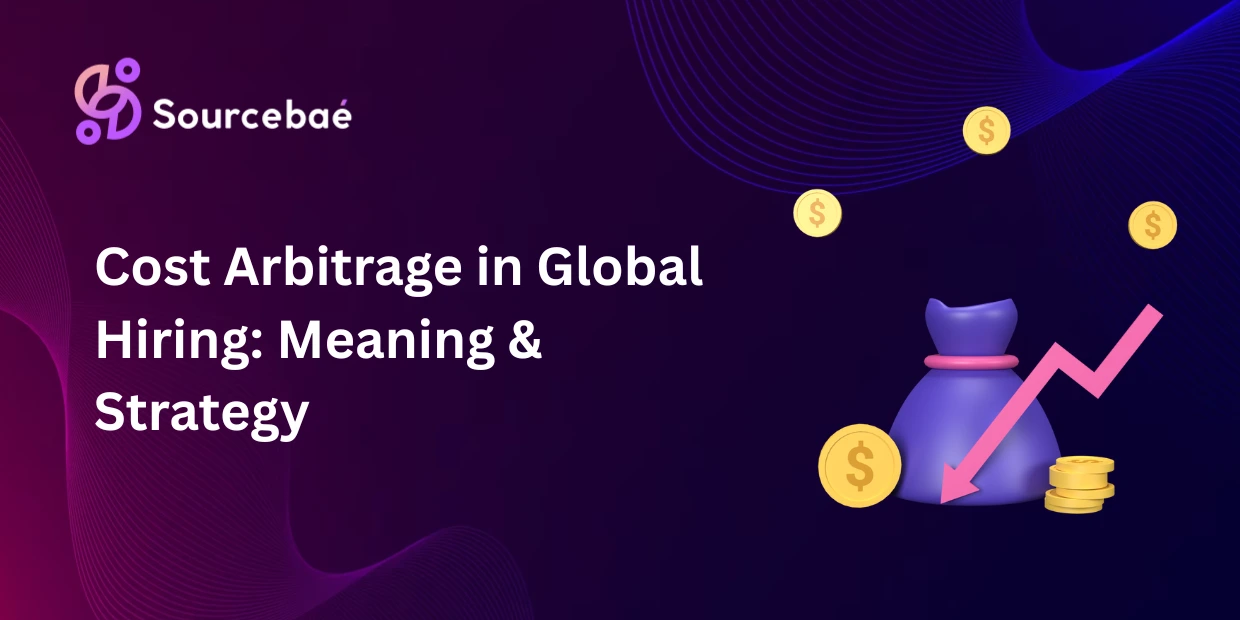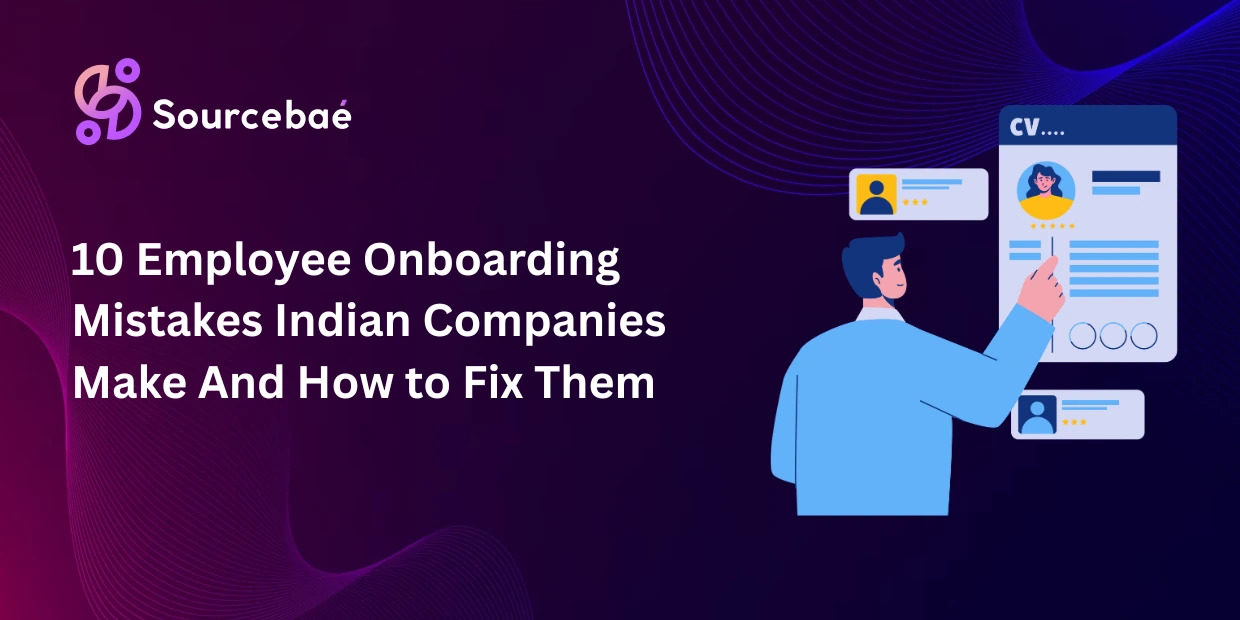Global hiring has changed the way companies think about teams, budgets, and growth. Instead of limiting themselves to one city or country, businesses now hire wherever skills are strong and costs are efficient. That’s where cost arbitrage comes in.
Done right, cost arbitrage in global hiring can cut total hiring costs, extend your runway, and unlock 24/7 productivity—without compromising on talent quality.
In this guide, we’ll break down cost arbitrage meaning, how labour cost arbitrage works, benefits, risks, and best practices so you can use it as a strategic advantage, not just a cost-cutting hack.
What is Cost Arbitrage in Global Hiring?
In simple words, cost arbitrage means taking advantage of cost differences between two markets for the same asset or service.
In global hiring, cost arbitrage happens when you:
- Hire talent in countries where labor costs are lower
- But skills and output quality are comparable to higher-cost markets
For example, a senior engineer or data analyst who costs $150,000 per year in a Tier-1 US city might cost $40,000–$60,000 in India, Eastern Europe, or Latin America for similar skill levels and performance. This gap is labour cost arbitrage or labor cost arbitrage. Outsource Accelerator+1
Cost Arbitrage Meaning & Definition (In Plain English)
If you’re searching for “cost arbitrage meaning” or “cost arbitrage definition”, here’s a simple version:
Cost arbitrage is the practice of earning more value or profit by using price differences between two markets for the same work or asset.
In hiring, this means:
- Same role
- Similar skills
- Different countries
- Different salary levels
You hire where the talent is more affordable but still high-quality, and the difference becomes your strategic advantage.
Labor Cost Arbitrage vs Cost of Carry Arbitrage
The phrase “cost of carry arbitrage” usually comes from finance. It refers to profiting from price gaps between a financial asset (like a stock or commodity) and its futures contract, after accounting for costs like interest, storage, or dividends.
- Cost of carry arbitrage = financial markets, futures pricing
- Labor cost arbitrage = people and salaries across countries
Both rely on price differences, but in global hiring, you’re arbitraging wage and cost-of-living gaps rather than asset prices. growthngo.org+1
Factors Driving Cost Arbitrage in Global Hiring
Cost arbitrage doesn’t exist by accident. Several structural factors make global labour cost arbitrage possible.
1. Wage and Cost-of-Living Gaps
Salaries differ massively between countries for the same role:
- A developer in the US or UK may earn 3–5x more than a developer in India, Vietnam, or Colombia with similar skills.
- Yet, that local salary in a lower-cost country still represents a strong, competitive income because housing, food, and services cost less.
This is the core of labor cost arbitrage meaning: you pay regionally fair salaries which are lower than what you would pay in a high-cost country, while still being attractive locally. Outsource Accelerator+1
2. Cost of Living & Compensation Expectations
Professionals in lower cost-of-living markets don’t need San-Francisco-level salaries to live comfortably. A package that seems “low” in dollars in New York can be excellent in cities like Bengaluru, Manila, or Kraków.
Because expectations are linked to local living costs, employers can:
- Offer competitive local salaries
- Still spend much less per hire than in their home country
3. Exchange Rate Advantages
When you pay in a stronger currency (USD, EUR, GBP), your budget stretches further in markets with weaker currencies.
For example:
- A $3,000/month salary can be significantly above local averages in many emerging economies.
- You can upgrade to better talent while still enjoying cost savings compared to hiring locally in high-cost markets. Outsource Accelerator
4. Talent Supply vs Demand
Some countries produce more skilled graduates than local markets can fully absorb, especially in tech and digital roles.
- India, Eastern Europe, parts of Latin America, and Southeast Asia have strong STEM education pipelines.
- This creates an oversupply of skilled talent, making wages more competitive globally. growthngo.org+1
Global hiring lets you tap into this talent pool instead of competing only in crowded, expensive local markets.
5. Statutory Costs & Employer Overheads
The total cost of employment goes beyond salaries. It includes:
- Payroll taxes
- Social security contributions
- Healthcare and benefits
- Local compliance costs
In many Western economies, these can add 20–30% (or more) on top of base salary. In many emerging markets, statutory overheads are lower, making total cost per hire even more attractive. auxis.com+1
6. Remote Work & Modern Infrastructure
Remote work, cloud tools, and collaboration platforms have made cost arbitrage outsourcing easier than ever. Companies can now:
- Hire fully remote teams
- Use Employer of Record (EOR), RPO providers, or offshore partners
- Manage distributed teams almost as smoothly as local ones Outsource Accelerator+1
Types of Arbitrage (and Where Cost Arbitrage Fits In)
When people ask “what is cost arbitrage?” or search for “cost arbitrage meaning”, they’re usually comparing it with other kinds of arbitrage used in business and finance. Below are some of the most important types, and how they relate to global hiring and labour cost arbitrage.
1. Cost Arbitrage (Business & Global Hiring)
Cost arbitrage happens when a company takes advantage of cost differences between two markets to get the same work or value at a lower price.
- In global hiring, cost arbitrage means hiring skilled talent in lower-cost countries while maintaining similar quality.
- This is where labour cost arbitrage or labor cost arbitrage comes in: salary, benefits, and overheads are lower, but the work output can match or even exceed high-cost markets.
If you want a simple cost arbitrage definition:
Cost arbitrage is using price differences between locations to lower your total cost for the same service, role, or outcome.
When you do this via partners or offshore teams, it’s often called cost arbitrage outsourcing.
2. Labor / Labour Cost Arbitrage
Labor cost arbitrage (or labour cost arbitrage) is a more specific form of cost arbitrage focused only on people and salaries.
- You hire talent in regions where wages are lower but skills are strong.
- You pay fair, locally competitive salaries.
- Your total cost per hire is still much lower than in your home country.
Put simply, labor cost arbitrage meaning is: “same job, similar skill, different country, lower cost.”
This is the main lever companies use in global hiring and remote team building.
3. Cost of Carry Arbitrage (Financial Markets)
Cost of carry arbitrage belongs more to finance than HR, but it often appears when people search for cost arbitrage.
- It’s used in futures and derivatives trading.
- Traders look at the price of an asset today vs. the futures price.
- They factor in the cost of carry (interest, storage, insurance, etc.).
- If there’s a profitable gap, they buy in one market and sell in another.
So while cost of carry arbitrage and cost arbitrage in hiring share the word “arbitrage,” they solve very different problems:
- Cost arbitrage in hiring: wage and location differences
- Cost of carry arbitrage: price and financing differences in assets
4. Geographic / Location Arbitrage
Sometimes called geo-arbitrage, this is closely related to cost arbitrage:
- A company sets up teams, offices, or GCCs in locations where costs are lower.
- A founder might live and hire in a Tier-2 city instead of a Tier-1 city to stretch their budget.
- In global hiring, this becomes location-based labour cost arbitrage.
You’re still applying the same cost arbitrage meaning: use location-based price differences to get more value for every dollar spent.
5. Skill or Knowledge Arbitrage
This type of arbitrage is about where skills are concentrated:
- Some regions have a high supply of engineers, data analysts, or AI specialists.
- If your local market is expensive and saturated, you tap into these regions.
- The combination of deep skill pools + lower cost is both skill arbitrage and labor cost arbitrage.
Many companies combine skill arbitrage with cost arbitrage outsourcing by working with specialized partners who already know where to find this talent globally.
Benefits of Leveraging Cost Arbitrage
When you understand the drivers, cost arbitrage in global hiring becomes more than a cost-saving tactic—it’s a growth lever.
1. Lower Total Hiring & Operating Costs
The obvious benefit: you pay less per role while keeping quality high.
- Lower base salary
- Lower overhead costs
- Lower office and infrastructure costs (if remote or hybrid)
This is the core of cost arbitrage outsourcing—using external or offshore talent to deliver the same output at a lower total cost.
2. Longer Runway & Better Unit Economics
For startups and scale-ups, labour cost arbitrage can:
- Extend runway without raising extra capital
- Improve unit economics (revenue vs cost per employee)
- Free budget for product, GTM, and R&D
Enterprises can reallocate savings to innovation, new markets, or higher-value roles instead of just payroll. auxis.com+1
3. Access to a Global Talent Pool
Cost arbitrage isn’t just about “cheap talent.” It often unlocks specialized skills that may be scarce locally:
- Niche tech stacks
- Data, AI, and analytics
- Cybersecurity, DevOps, cloud
- Multilingual customer support
You’re no longer constrained by your local market — you can hire the best person for the job, anywhere.
4. 24/7 Coverage & Faster Delivery
Distributed teams across time zones can:
- Hand off work around the clock
- Support global customers in multiple regions
- Reduce turnaround time on critical projects
This combination of talent arbitrage + time zone arbitrage can deliver both cost and speed advantages.
5. Risk Diversification
Instead of concentrating all your talent in one city or country, global hiring spreads risk:
- Political or economic instability
- Local regulatory changes
- Talent shortages in a single region
A well-designed global labour cost arbitrage strategy balances cost savings with resilience.
How to Do It Right: Best Practices
Cost arbitrage can backfire if treated as a race to the bottom. Here’s how to build a sustainable, ethical, and high-performing global hiring strategy.
1. Segment Roles Before You Offshore
Not every role should be offshored or outsourced.
Best suited for cost arbitrage:
- Engineering, QA, data, design
- Back-office operations and support
- Customer service, sales ops, basic finance & HR processes
Less suited (or more sensitive):
- Roles needing heavy in-person collaboration
- Highly regulated or security-sensitive roles (unless you have strong controls)
Start with non-core but essential functions, then gradually move up the value chain as your model matures.
2. Focus on Value, Not Just the Lowest Cost
The biggest mistake in labour cost arbitrage is chasing the cheapest vendor, country, or partner.
Instead, evaluate:
- Talent quality & seniority
- Language and communication skills
- Time zone overlap with your core team
- Track record on delivery, security, and retention
The goal is better value per dollar, not just the lowest hourly rate.
3. Design Fair, Region-Appropriate Compensation
Cost arbitrage is not an excuse to underpay or exploit.
- Pay above-average local rates for top talent
- Offer benefits aligned with local norms (healthcare, learning, bonuses)
- Create clear growth paths and performance reviews
This keeps your global teams motivated and helps avoid high attrition, which can wipe out any cost gains. LinkedIn+1
4. Choose the Right Engagement Model
There are multiple ways to execute cost arbitrage outsourcing:
- Direct hiring (with local entities or EOR providers)
- Outsourcing/BPO partners for specific processes
- RPO (Recruitment Process Outsourcing) for global talent acquisition
- GCCs / captive centers in talent-rich, lower-cost regions
Each has trade-offs in:
- Control vs flexibility
- Speed vs complexity
- Upfront vs long-term costs Wikipedia+1
Choose a mix that fits your size, risk appetite, and growth plans.
5. Invest Heavily in Communication & Culture
Global teams only work when communication is intentional.
- Standardize tools (Slack/Teams, project management, documentation)
- Set clear working hours, hand-off rituals, and escalation paths
- Train managers to lead distributed teams
- Invest in virtual rituals and occasional in-person meetups
Without this, misunderstandings and misalignment can erode the benefits of cost arbitrage in global hiring.
6. Build Strong Governance & Compliance
When hiring across borders, you must handle:
- Local labor laws and tax requirements
- Data protection, security, and IP controls
- Compliance with standards (e.g., ISO, SOC, GDPR) where applicable
Use trusted EORs, legal counsel, and vetted vendors to keep compliance tight while benefiting from arbitrage.
7. Measure ROI Beyond Salary Savings
To know whether your labor cost arbitrage strategy is working, track:
- Time-to-hire and time-to-productivity
- Quality metrics (defect rates, NPS, customer satisfaction, SLAs)
- Retention and attrition
- Total cost per output unit (e.g., feature shipped, ticket resolved, report delivered)
This keeps you focused on outcomes, not just input costs.
Conclusion
Cost arbitrage in global hiring is no longer a niche strategy. It’s a core part of how modern companies build high-performing, distributed teams.
Understanding cost arbitrage meaning, the mechanics of labour cost arbitrage, and the difference from concepts like cost of carry arbitrage helps you use it strategically—not just tactically.
If you:
- Hire in the right markets
- Pay fairly for local conditions
- Choose the right outsourcing or global hiring model
- Invest in culture, communication, and compliance
…you can turn cost arbitrage from a temporary cost hack into a long-term competitive advantage in talent, speed, and scalability.
FAQs about Cost Arbitrage in Global Hiring
1. What is cost arbitrage in simple words?
Cost arbitrage is the practice of taking advantage of price differences for the same work or asset between two markets. In global hiring, it means hiring talent where salaries and total employment costs are lower while maintaining similar skill and quality levels.
2. What is labor cost arbitrage meaning in outsourcing?
Labor cost arbitrage (or labour cost arbitrage) in outsourcing means shifting work to regions where labor is cheaper but skilled, so you can deliver the same services at a lower total cost. It’s common in IT, customer support, finance operations, and other business process outsourcing. Wikipedia+1
3. Is cost arbitrage the same as cost of carry arbitrage?
No.
- Cost arbitrage in hiring is about wage and cost-of-living differences between countries.
- Cost of carry arbitrage is a financial strategy involving futures contracts and the cost of holding an asset (like interest, storage, or dividends). growthngo.org
They share the idea of profiting from price gaps, but they apply to completely different domains.
4. Is labour cost arbitrage ethical?
Labour cost arbitrage can be ethical if:
- You pay fair, region-appropriate salaries
- Respect local labor laws and working conditions
- Offer growth opportunities and treat global teams as true partners
It becomes problematic when companies underpay, ignore compliance, or treat global workers as disposable.
5. Does cost arbitrage in global hiring always reduce quality?
No. In many cases, you gain access to more specialized or experienced talent than you could afford in a high-cost market. Quality drops only when cost is prioritized over:
- Skill and experience
- Communication and culture fit
- Governance, training, and management
The best strategies combine cost arbitrage with high standards in hiring, onboarding, and ongoing management.
6. How is cost arbitrage different from offshoring?
- Offshoring describes moving work to another country (often for cost reasons).
- Cost arbitrage describes the economic logic behind it—leveraging wage and cost differences.
You can offshore without meaningful cost arbitrage (e.g., for talent access or time zones), and you can achieve cost arbitrage through nearshoring, remote hiring, or hybrid models.






